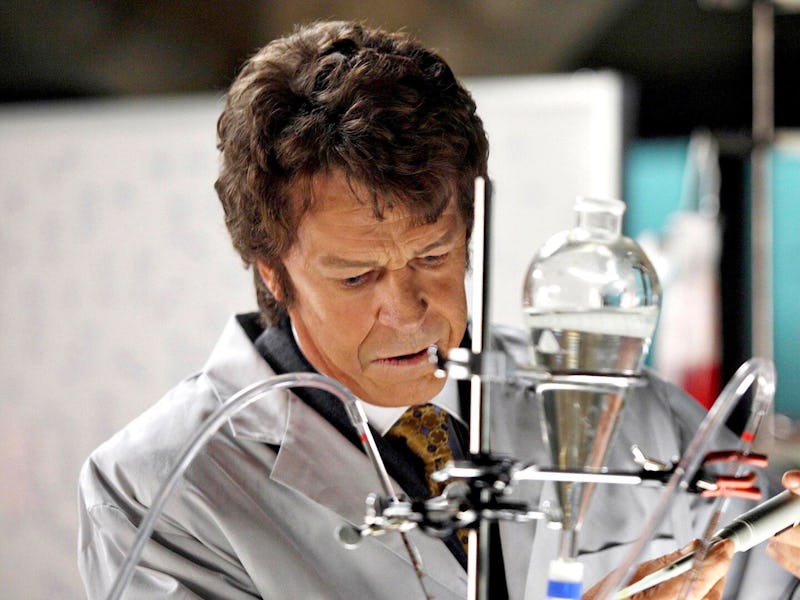With “Peter,” Fringe Proved Itself to Be More Than an X-Files Knock-Off
“Peter” changed the way we saw Walter Bishop — and the show.

How far will you go to save a loved one? What’s possible in science fiction often comes down to exploring life’s more intimate moments and relationships. For Fringe, this meant turning its emotional focal point from the tragic romance between an FBI Agent and her lover-turned-bad-guy FBI partner, to the estrangement of a father and son. To do so, the sci-fi series explored the lengths a father will go to save his child. And breaking the universe is only the beginning.
Like The X-Files before it, Fringe originally took a procedural approach, with each episode following the characters as they investigated cases of fringe science (telekinesis, mind control, time travel, etc), tied to a vague overarching mythos. As the series went on, storylines became more serialized as mysteries kept growing. Unlike The X-Files, Fringe had answers. Those answers came in the Season 2 flashback episode “Peter,” which recontextualized everything we knew about Walter Bishop (John Noble) and his son Peter (Joshua Jackson), while painting a unique portrait of death, grief, and fate.
Despite the title, this flashback episode belongs to Walter. Before “Peter,” we’ve known Walter Bishop to be a well-meaning, funny, often tactless scientist who sometimes carelessly ran dangerous experiments. For this reason, and the many secrets he hid (even from himself), he was estranged from his son for almost two decades. “Peter” fully pulls back the curtain on Walter, and reveals why exactly an alternate universe is creeping into ours.
Beginning with an ‘80s-inspired title sequence that replaces the usual fringe science topics with things like “DNA profiling,” “personal computing,” “laser surgery,” “virtual reality,” and “in vitro fertilization,” “Peter” takes us to 1985. Though the episode is bookended by scenes between present-day Olivia (Anna Torv) and Walter, Walter in 1985 searches for a cure to an illness that’s killing 7-year-old Peter. His solution? To watch “Walternate” — Walter’s name for his alternate universe version of himself — through a time window he’s created.
Alternate Peter (Quinn Lord) was kidnapped by Walter, who inadvertently created the cracks in the universe.
The other universe is more technologically advanced (though Walter Prime has beaten them to universe-hopping it seems), so Walter watches Walternate try to come up with the cure for Peter in order to copy Walternate’s work on his end. But tragedy strikes first — Peter in our universe dies. Instead of grieving properly, Walter focuses on saving the other Peter, eventually taking him to his universe and never returning him.
In this act of kidnapping, Walter created the first crack in the universe — the reason that all of the fringe science in the present day is possible. This decision, steeped in good intentions and understandable grief, ultimately defines Walter for the rest of the show, and changes the fate of not just his son, but of two worlds as well.
The striking thing about “Peter” is its focus on Peter’s parents — all four of them. We don’t get a lot of Walternate, but through the time window, we see just how driven he is to find a cure for his son. This is also the first time we meet Peter’s mother. The alternate universe Elizabeth loves her son and trusts her husband while still questioning his methods. Elizabeth in the Prime universe is driven by her grief after losing her son. We know she committed suicide sometime when Peter was a teenager, but the beautiful performance by Orla Brady gives Elizabeth Prime a tragically layered backstory. Knowing her ending but understanding her grief is a powerful introduction to her character.
Walter crosses dimensions to save his son.
It’s Walter Prime that we come to understand fully. This wacky scientist we’ve watched for a season and a half as he goofs around his lab is all of a sudden a step above God. Through every step of Walter’s decision to save the other Peter, there’s a struggle between his ego, his grief, and his good intentions. Only Noble could pull off this balance. When Alternate Elizabeth tells Walter Prime to bring her son back to her (thinking he’s just taking him to his lab for the cure) the look on Walter’s face says it all: despite his promise to her, he’s not returning Peter.
The prime parents are a great inversion of the alternate universe parents. We don’t see their grief after Peter is kidnapped, but we do see Walter and Elizabeth Prime’s grief over the death of their son, and the relief and love when they have Alternate Peter in front of them. Those are all the answers we need to understand the magnitude of what Walter Prime has done to two parents.
The episodes preceding “Peter” shows us the damage Walter created from crossing over initially — all of those cases they’ve investigated were only possible because of that universe break in 1985. And in the episodes to come, Peter will start to question his place in the world. “Peter” finally reveals not just the mystery of Peter Bishop but the show’s heart and the danger of good intentions.